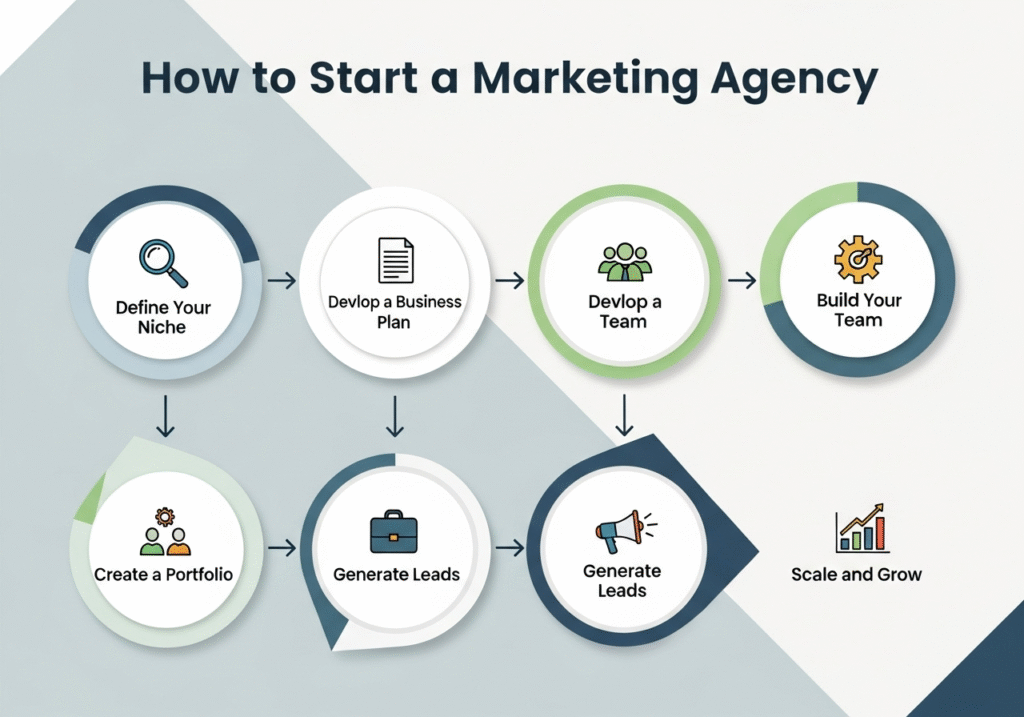Getting your website to rank higher in search results doesn’t stop at on-page optimization. Off-page SEO is where the real magic happens, and the game has evolved far beyond basic link building. These cutting-edge off-page SEO formulas can transform your website’s visibility and drive the organic traffic you’ve been chasing.
This guide is perfect for digital marketers, business owners, and SEO professionals who want to move beyond beginner tactics and implement advanced strategies that actually work. If you’re tired of generic advice and ready to use proven off-page SEO techniques that deliver measurable results, you’re in the right place.
We’ll dive deep into advanced link building strategies that go way beyond guest posting, showing you how to build authority through relationships and strategic partnerships. You’ll also discover how to leverage social media signals and brand mentions to boost your search engine visibility, even when those mentions don’t include direct backlinks. Plus, we’ll break down the technical off-page elements and local SEO tactics that can give you a serious competitive edge in your market.
Ready to skyrocket your rankings with these advanced SEO formulas? Let’s get started.
Advanced Link Building Strategies That Deliver Results

Authority Site Outreach Techniques for High-Quality Backlinks
Building relationships with authority websites starts with understanding their content gaps and audience needs. The most effective link building strategies focus on creating genuine value rather than simply asking for links. Start by identifying websites with high domain authority in your niche using tools like Ahrefs or SEMrush, then analyze their recent content to find opportunities where your expertise could add meaningful insights.
The skyscraper technique remains one of the most powerful advanced SEO formulas when executed properly. Find popular content in your industry, create something significantly better, then reach out to sites that linked to the original piece. Your outreach email should highlight specific improvements you’ve made—whether that’s more recent data, better visuals, or additional expert perspectives.
Personalization separates successful campaigns from spam. Research the website owner’s recent posts, social media activity, or company news before reaching out. Reference their work specifically and explain how your content complements their existing resources. This approach builds trust and increases response rates dramatically.
Resource Page Link Acquisition Methods
Resource pages represent goldmine opportunities for backlink strategies because they’re specifically designed to link out to valuable content. Use search operators like “keyword + resources,” “best tools for [topic],” or “useful links” to find relevant resource pages in your industry.
When targeting resource pages, your content must genuinely deserve a spot among their recommendations. Create comprehensive guides, free tools, or data-driven research that provides immediate value to their audience. The key is matching the quality and format of existing resources while offering something unique.
Your outreach should emphasize the mutual benefit—how your resource helps their visitors achieve specific goals. Include metrics like user engagement, social shares, or expert endorsements to demonstrate credibility. Many resource page curators appreciate when you suggest where your link might fit best within their existing structure.
Broken Link Building for Competitive Advantage
Broken link building combines helpfulness with strategic off-page SEO techniques. Website owners hate broken links because they create poor user experiences and can hurt search rankings. When you identify broken links and offer working replacements, you’re solving a real problem while earning quality backlinks.
Use tools like Check My Links browser extension or Screaming Frog to identify broken external links on target websites. Focus on resource pages, blog posts, and industry directories where broken links are most common. The content you create to replace broken links should match the original topic and provide equal or better value.
Your outreach message should lead with the broken link notification—this immediately demonstrates you’re providing value. Then mention your replacement resource as a natural solution. This approach works because you’re helping before asking for anything in return, creating goodwill that often leads to additional linking opportunities.
Guest Posting on Industry-Leading Platforms
Strategic guest posting remains one of the most effective website SEO growth tactics when done correctly. The key is targeting platforms where your ideal audience already spends time, not just any site that accepts guest posts. Research publications your competitors write for and identify emerging platforms with engaged audiences.
Quality trumps quantity in modern guest posting. One well-placed article on a respected industry publication delivers more value than dozens of posts on low-quality sites. Study the publication’s content style, audience preferences, and editorial guidelines before pitching. Your topics should align with their recent content themes while offering fresh perspectives.
Build relationships with editors by engaging with their content on social media and sharing their articles before you pitch. When you do reach out, propose specific topics with clear outlines and demonstrate your expertise through previous work samples. Many editors prefer working with contributors who understand their audience and can deliver publication-ready content consistently.
The most successful guest posting campaigns focus on long-term relationship building rather than one-off transactions. Regular contributors often receive better placement, more promotional support, and additional opportunities like speaking engagements or collaborative projects.
Social Media Signals That Boost Search Engine Visibility

Strategic Social Bookmarking for Maximum Impact
Social bookmarking platforms like Reddit, StumbleUpon, and Mix can generate substantial traffic and powerful backlinks when approached strategically. The key lies in understanding that these platforms prioritize community value over self-promotion.
Start by identifying niche-specific bookmarking sites where your target audience actively engages. For B2B content, platforms like Flipboard and Scoop.it work exceptionally well, while lifestyle brands thrive on Pinterest and We Heart It. Create authentic profiles with complete information and engaging bio content that establishes credibility.
Timing and frequency matter significantly. Research when your target community is most active and schedule submissions accordingly. Most successful marketers follow the 80/20 rule: 80% valuable content from others, 20% your own material. This approach builds trust and prevents spam flags that could damage your SEO efforts.
Use compelling titles that spark curiosity without resorting to clickbait tactics. Search engines analyze social engagement metrics, so titles that generate genuine clicks and discussions will boost your overall visibility. Include relevant hashtags and detailed descriptions that naturally incorporate your target keywords.
Social Platform Engagement Optimization
Creating meaningful conversations across social platforms directly impacts your website’s search engine rankings. Search engines like Google track social signals as indicators of content quality and relevance, making engagement optimization crucial for cutting-edge off-page SEO formulas.
Focus on platforms where your audience spends the most time rather than trying to maintain presence everywhere. LinkedIn excels for professional services, Instagram dominates visual industries, and Twitter works well for news and trending topics. Each platform requires tailored content strategies that align with user expectations.
Engagement metrics that influence SEO include:
- Comment depth and quality
- Share velocity and reach
- Cross-platform mentions
- User-generated content creation
- Community participation levels
Respond promptly to comments and messages to maintain active engagement rates. Ask questions that encourage responses and create polls that drive interaction. Share behind-the-scenes content that humanizes your brand and encourages authentic conversations.
Cross-promote content strategically by adapting the same core message for different platform audiences. What works as a detailed LinkedIn article might become an Instagram carousel or Twitter thread, maximizing your content’s reach and engagement potential.
Viral Content Creation for Natural Link Generation
Viral content generates organic backlinks by creating value that people naturally want to share and reference. This approach requires understanding emotional triggers, trending topics, and content formats that resonate with your specific audience segments.
Research trending hashtags and current events that relate to your industry. Tools like BuzzSumo and Google Trends reveal what content performs well in your niche. Create timely content that adds unique perspectives to ongoing conversations rather than simply repeating existing viewpoints.
High-performing viral content typically includes:
| Content Type | Engagement Driver | SEO Benefit |
|---|---|---|
| Educational Infographics | Visual learning appeal | Link magnets for resources |
| Interactive Tools | Practical utility | Extended session duration |
| Behind-the-scenes Videos | Authenticity factor | Social sharing boost |
| Controversial Takes | Discussion catalyst | Comment engagement |
| Data-driven Reports | Authority building | Reference citations |
Controversial content can drive massive engagement, but balance opinions with factual backing to maintain credibility. Create content that solves genuine problems or entertains meaningfully rather than manufacturing drama for attention.
Collaborate with influencers and industry experts to amplify your content’s reach. Their audiences often trust recommendations, leading to higher engagement rates and natural link building opportunities. Track which collaborations generate the most valuable backlinks and replicate those partnership strategies.
Local SEO Off-Page Tactics for Dominating Geographic Markets

Google My Business Optimization Strategies
Your Google My Business profile acts as your digital storefront for local searches. Start by claiming and verifying your business listing across all locations. Upload high-quality photos weekly, including interior shots, exterior views, team photos, and products or services in action. These visual elements can increase engagement by up to 42%.
Post regular updates about events, offers, and company news using Google My Business posts. These updates signal freshness to search algorithms and keep your audience engaged. Enable messaging features to respond to customer inquiries directly through your profile.
Optimize your business description with location-specific keywords naturally woven into compelling copy. Include your primary service area and key offerings without keyword stuffing. Add all relevant business categories and attributes that accurately describe your services.
Local Citation Building and Directory Submissions
Consistent NAP (Name, Address, Phone) information across all online directories creates a foundation for local authority. Focus on high-authority directories like Yelp, Yellow Pages, and industry-specific platforms relevant to your business.
Create a citation tracking spreadsheet to monitor where your business appears online. Audit existing citations quarterly to fix inconsistencies that can confuse search engines and potential customers.
Target niche directories within your industry and geographic area. A local restaurant should prioritize food delivery apps and local dining guides over generic business directories. Quality beats quantity when building citations that actually drive traffic and improve rankings.
Community Engagement for Local Authority Building
Real community involvement translates into authentic local SEO signals. Partner with local nonprofits, sponsor community events, and participate in chamber of commerce activities. These relationships often result in natural backlinks from respected local organizations.
Host or participate in local events that generate media coverage and social media mentions. A business that becomes part of the community fabric earns trust signals that search engines recognize and reward.
Collaborate with other local businesses for cross-promotional opportunities. Joint ventures, referral programs, and community initiatives create a network of local connections that strengthen your digital presence organically.
Review Management Systems That Convert
Proactive review management goes beyond asking for feedback. Create systematic approaches for earning reviews across multiple platforms. Send follow-up emails after service completion with direct links to review platforms.
Respond to all reviews professionally and promptly. Your responses show potential customers how you handle feedback and demonstrate your commitment to customer service. Negative reviews become opportunities to showcase your problem-solving abilities.
Implement review widgets on your website to display recent positive feedback. This social proof improves conversion rates while keeping fresh content on your pages. Monitor review platforms regularly to address concerns before they escalate.
Brand Mention Optimization Without Direct Links

Unlinked Brand Mention Discovery and Conversion
Brand mentions without backlinks represent untapped SEO goldmines that most businesses completely overlook. These unlinked mentions already show that people are talking about your brand, making them prime conversion opportunities for building authority signals.
Start by setting up Google Alerts for your brand name, products, and key executives. Tools like Mention.com, Brand24, or Ahrefs’ Content Explorer can track brand mentions across millions of web pages, social platforms, and news sites. Look beyond exact brand matches – search for variations, common misspellings, and related terms that people might use when discussing your business.
Once you’ve identified unlinked mentions, prioritize them based on domain authority and relevance. High-authority sites like industry publications, news outlets, and popular blogs should be your first targets. Craft personalized outreach emails that thank the author for mentioning your brand and politely suggest adding a link for readers who want to learn more.
The key to successful conversion lies in providing value rather than making demands. Offer additional information, updated statistics, or exclusive insights that could enhance their content. Many publishers will add links when they see genuine value for their readers.
Track your conversion rates and follow up strategically. Some mentions might not convert immediately, but maintaining relationships with these publishers can lead to future linking opportunities and collaborative content projects.
Influencer Collaboration for Brand Awareness
Modern influencer collaboration goes far beyond simple sponsored posts – it’s about building authentic relationships that generate organic brand mentions and referral traffic. The most effective approach focuses on micro-influencers who have engaged audiences in your niche rather than chasing follower counts.
Research influencers who already align with your brand values and regularly engage with topics related to your industry. Tools like BuzzSumo, Upfluence, or AspireIQ can help identify potential collaborators based on engagement rates, audience demographics, and content quality.
Create collaboration opportunities that feel natural and valuable to their audience. Product trials, exclusive behind-the-scenes content, expert interviews, and co-created educational materials work better than obvious promotional content. When influencers genuinely enjoy your product or service, their authentic recommendations carry more weight with both their followers and search engines.
Develop long-term partnerships rather than one-off campaigns. Regular collaborators become brand advocates who naturally mention your business in various contexts, creating diverse mention patterns that search engines view favorably. These ongoing relationships also lead to cross-promotional opportunities and expanded reach within interconnected influencer networks.
Track mentions across all platforms where your collaborators are active. Instagram stories, TikTok videos, YouTube descriptions, and blog posts all contribute to your overall brand visibility and can drive significant referral traffic when executed correctly.
PR and Media Coverage Acquisition Techniques
Strategic PR outreach creates high-authority brand mentions that significantly boost your off-page SEO profile. The secret lies in developing newsworthy angles that journalists actually want to cover, rather than pushing generic company updates that end up in spam folders.
Monitor trending topics in your industry using Google Trends, Twitter hashtags, and news aggregators like Feedly. When you spot emerging stories, quickly develop expert commentary, original data, or unique perspectives that add value to ongoing conversations. Speed matters – journalists working on breaking stories need sources fast.
Build relationships with reporters before you need them. Follow journalists who cover your beat on social media, engage with their content meaningfully, and share their articles when relevant. Many successful PR campaigns start with existing relationships rather than cold outreach.
Create compelling story angles using the PESO model (Paid, Earned, Shared, Owned media). Survey your customers to generate original data, partner with other brands for newsworthy collaborations, or tie your expertise to current events. Stories with human interest angles, surprising statistics, or contrarian viewpoints perform better than straight product announcements.
Develop relationships with podcast hosts, YouTube creators, and newsletter publishers in your space. These platforms often provide longer-form coverage that generates multiple brand mentions and detailed discussions about your expertise. The conversational nature of these formats also tends to feel more authentic to audiences.
Time your outreach strategically around industry events, seasonal trends, and news cycles. A well-timed pitch during slow news periods has a much higher chance of getting picked up than competing with major breaking stories.
Technical Off-Page Elements That Search Engines Love

Schema Markup Implementation for Enhanced Visibility
Schema markup acts as a secret language between your website and search engines, helping them understand your content better. When you implement structured data correctly, you’re essentially giving search engines a roadmap to your content’s meaning and context.
The most powerful schema types for off-page SEO techniques include Organization, LocalBusiness, Product, Review, and FAQ schemas. These markup types create rich snippets that make your listings stand out in search results with star ratings, pricing information, and business details.
Google’s Rich Results Test tool becomes your best friend here. Test every schema implementation before going live, and monitor your rich snippet performance through Google Search Console. Keep track of which schemas generate the most clicks and impressions.
Key Schema Implementation Strategy:
- Article schema for blog posts and news content
- Product schema for e-commerce listings
- Review schema for customer testimonials
- Event schema for webinars and conferences
- FAQ schema for common customer questions
Site Speed Optimization Through External Factors
Your website’s loading speed depends heavily on external elements beyond your server. Content Delivery Networks (CDNs) represent the most impactful advanced SEO formulas for speed optimization, distributing your content across global servers to reduce loading times for users worldwide.
Choose CDN providers like Cloudflare, Amazon CloudFront, or KeyCDN based on your geographic audience. Configure your CDN to cache static resources like images, CSS, and JavaScript files for maximum efficiency.
External DNS optimization often gets overlooked but plays a crucial role in site speed. Fast DNS providers like Cloudflare DNS or Google Public DNS can shave milliseconds off your loading times, which accumulate into noticeable improvements.
External Speed Optimization Checklist:
- Implement a robust CDN solution
- Optimize external DNS settings
- Minimize third-party script dependencies
- Use efficient external font loading strategies
- Optimize external API calls and integrations
Mobile-First Indexing Compliance Strategies
Google’s mobile-first indexing means your mobile version determines your search rankings. Your mobile site needs to contain the same content depth and quality as your desktop version, with no shortcuts or simplified versions that might hurt your SEO ranking techniques.
Responsive design remains the gold standard, but Progressive Web App (PWA) implementation takes mobile optimization to the next level. PWAs provide app-like experiences with offline functionality, push notifications, and lightning-fast loading speeds.
Test your mobile experience using Google’s Mobile-Friendly Test and PageSpeed Insights mobile version. Pay special attention to touch targets, font sizes, and navigation elements that might frustrate mobile users.
Mobile-First Optimization Priorities:
- Ensure content parity between mobile and desktop
- Implement touch-friendly navigation elements
- Optimize images for mobile viewing
- Test loading speeds on 3G connections
- Validate structured data on mobile versions
Core Web Vitals Enhancement Through Off-Page Methods
Core Web Vitals focus on user experience metrics that directly impact rankings. While many optimizations happen on-page, several off-page optimization tips can significantly improve these vital scores.
Largest Contentful Paint (LCP) improves dramatically with proper CDN implementation and image optimization through external services like TinyPNG or ImageOptim. Consider using next-generation image formats like WebP through your CDN provider.
First Input Delay (FID) benefits from reducing third-party JavaScript dependencies. Audit your external scripts regularly and remove unnecessary tracking codes, social media widgets, or outdated analytics tools that slow down interactivity.
Cumulative Layout Shift (CLS) requires careful management of external resources. Always specify dimensions for images, videos, and ads to prevent content jumping as elements load.
| Core Web Vital | Off-Page Solution | Expected Impact |
|---|---|---|
| LCP | CDN + Image Optimization | 30-50% improvement |
| FID | Third-party Script Audit | 20-40% improvement |
| CLS | External Resource Management | 25-60% improvement |
External monitoring tools like GTmetrix, Pingdom, or WebPageTest provide ongoing insights into your Core Web Vitals performance from different global locations, helping you identify regional performance issues that might affect your website SEO growth in specific markets.
Competitor Analysis and Reverse Engineering Success

Backlink Gap Analysis for Strategic Opportunities
Understanding where your competitors get their backlinks while you don’t reveals goldmine opportunities for your own link building campaigns. Start by collecting comprehensive backlink profiles of your top 3-5 competitors using tools like Ahrefs, SEMrush, or Majestic. Export these profiles and cross-reference them against your own to identify gaps.
Focus on high-authority domains that consistently link to multiple competitors but haven’t linked to you yet. These represent your best prospects since they already demonstrate interest in your industry’s content. Create a spreadsheet ranking these opportunities by domain authority, relevance score, and difficulty level.
Priority targeting matrix:
| Domain Authority | Industry Relevance | Outreach Difficulty | Priority Score |
|---|---|---|---|
| 70+ | High | Low | Critical |
| 50-69 | High | Medium | Important |
| 30-49 | Medium | Low | Standard |
| Below 30 | Any | Any | Low Priority |
Don’t overlook recurring patterns in competitor backlinks. If three competitors all have links from industry newsletters, guest posting networks, or resource pages, these represent systematic opportunities rather than one-off wins. Map out these link-building strategies and adapt them with your unique angle.
Content Gap Identification and Exploitation
Content gaps represent untapped keyword territories where competitors rank well but you’re nowhere to be found. Use content gap analysis tools to discover these blind spots in your SEO strategy. Start with organic keyword research, comparing your site’s ranking keywords against your top competitors.
Look for high-volume, low-difficulty keywords where competitors consistently rank in positions 1-10 while you don’t rank at all. These gaps often reveal entire content categories you’ve overlooked. Create comprehensive content that directly targets these opportunities while adding your unique perspective or superior depth.
Gap analysis workflow:
- Export competitor organic keywords (positions 1-20)
- Filter out branded terms and irrelevant queries
- Identify keywords with search volume >500/month
- Cross-check against your current content inventory
- Prioritize based on commercial intent and difficulty
Pay special attention to question-based keywords and long-tail phrases where competitors rank with thin content. You can often outrank established pages by creating more comprehensive, user-focused content that directly answers searcher intent.
Resource page opportunities also emerge from content analysis. When competitors consistently get mentioned on “best tools” or “top resources” lists, analyze what made their content link-worthy and create superior alternatives.
Competitor Social Media Strategy Replication
Social signals increasingly influence search rankings, making competitor social media analysis essential for cutting-edge off-page SEO formulas. Examine not just what your competitors post, but how they structure their social media presence to generate engagement and backlinks.
Track competitor posting schedules, content types, and engagement rates across platforms. Many successful competitors follow specific formulas for content distribution that you can adapt. If a competitor consistently gets high engagement on LinkedIn with industry insights posted at 9 AM Tuesday, test similar timing and format for your content.
Social monitoring checklist:
- Peak posting times and frequency patterns
- Content formats driving highest engagement
- Hashtag strategies and community participation
- Influencer partnerships and collaboration approaches
- Cross-platform content repurposing methods
Look beyond surface metrics to understand relationship-building strategies. Competitors who consistently engage with industry influencers, participate in Twitter chats, or host LinkedIn Live sessions often see these activities translate into natural backlink opportunities.
Monitor competitor-generated social proof like user-generated content, customer testimonials shared socially, and brand mentions. These reveal relationship-building tactics you can implement while building your own community of brand advocates.
Document which social posts generate the most website traffic and backlinks for competitors. This intelligence helps you craft social content designed specifically for off-page SEO impact rather than just engagement metrics.

Link building remains the backbone of successful off-page SEO, but today’s most effective strategies go far beyond basic guest posting. The advanced techniques we’ve covered—from leveraging social media signals to optimizing unlinked brand mentions—work together to create a powerful ranking engine. Local businesses can tap into geographic-specific tactics, while technical elements like schema markup and site speed optimization provide the foundation that search engines crave.
The real game-changer lies in understanding what your competitors are doing right and adapting their successes to your unique situation. Start by conducting a thorough competitor analysis, then implement these cutting-edge formulas one by one. Focus on building genuine relationships, creating valuable content that naturally attracts mentions, and consistently monitoring your progress. Your website’s climb to the top of search results begins with taking action on these proven strategies today.
FAQs
What are cutting-edge off-page SEO formulas?
Cutting-edge off-page SEO formulas are advanced strategies that focus on building authority, high-quality backlinks, and optimizing external signals to boost search rankings.
How can I apply cutting-edge off-page SEO formulas?
You can apply these formulas through strategic link building, guest posting, social media outreach, influencer collaborations, and directory submissions to improve your website’s authority.
Why are cutting-edge off-page SEO formulas important?
These formulas help increase domain authority, drive targeted traffic, improve search rankings, and strengthen your website’s overall SEO performance.
Can beginners use cutting-edge off-page SEO formulas effectively?
Yes. Beginners can start by focusing on a few proven off-page strategies like quality backlinks, guest posting, and social sharing while gradually expanding to advanced techniques.
Which tools are useful for cutting-edge off-page SEO formulas?
Tools like Ahrefs, SEMrush, Moz, and Majestic can help identify backlink opportunities, analyze competitor strategies, and track the performance of off-page SEO efforts.



